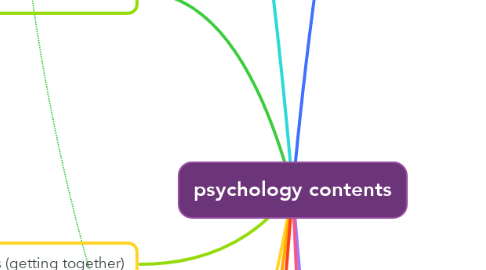
1. Memory
1.1. Ebbinghaus memory curve
1.1.1. help schedule study/revisions
1.2. Multistore Model of Memory
1.3. Context Maintenance and Retrieval
1.4. Working Memory Model (model for STM)
1.5. Schemas + reconstructive memory
1.5.1. Eye-witness testimonies
1.6. Flashbulb Memory Theory
1.6.1. Emotion + reliability of memory
1.7. Localization of Function
1.7.1. MTL - hippocampus (taxi drivers)
1.7.2. dense neural networks, synaptic pruning
1.7.3. **Neuroplasticity:** synaptogenesis, synaptic pruning, dendritic branching, neurogenesis
1.8. Neurotransmission
1.8.1. excitatory NT (acetylcholine, hippocampus with many receptors), scopolamine antagonist
2. Thinking and decision making
2.1. Dual Process Model (S1 & S2)
2.2. Heuristics & biases
2.2.1. Anchoring bias (consumerism)
2.2.2. Gambler's fallacy (law)
2.2.3. Framing effect (advertisement)
2.3. Somatic Markers Hypothesis
2.3.1. Emotion (vmPFC)
3. Relationships (getting together)
3.1. Social Penetration Theory
3.1.1. deep conversations (IAoL)
3.2. Filter Model
3.2.1. Similarity vs Complementary
3.3. Evolution & Sexual Selection
3.4. Localization of 'love'
3.4.1. dopaminergic reward system
3.5. *Pheromones
3.5.1. complementary immune system
3.6. Culture
4. Relationships (Working together)
4.1. Attribution Theory
4.1.1. situational attribution vs dispositional attribution (of blame)
4.1.1.1. Communication
4.2. Cooperation & Competition
4.2.1. Prisoner's dilemma
4.3. Prosocial behaviour
4.3.1. hormones (oxytocin)
5. Relationships (Falling apart)
5.1. Gottman’s four horsemen (thin slicing)
5.1.1. Criticism, contempt, defensiveness, stonewalling
6. Culture
6.1. Hofstede's Cultural Dimensions
6.1.1. Individualism vs Collectivism
6.1.1.1. mate choice (love/parental influence)
6.1.2. Feminism vs Masculism
6.1.3. long term vs short term orientation
6.1.4. Indulgence vs Restraint
6.1.5. Uncertainty avoidance
6.1.6. Power distance index
6.2. Enculturation
6.2.1. Social Cognitive Learning
6.2.1.1. Observe. remember, reproduce, motivation/vicarious reinforcement
6.3. Acculturation
6.3.1. Integration, Assimilation, Separation, Marginalization
6.3.1.1. Wellbeing & belonging
7. Research Methods
7.1. Research Methods
7.1.1. Qualitative
7.1.1.1. Naturalistic Observation
7.1.1.2. Interview: Focus Groups
7.1.1.3. Interview: Unstructured (narrative)
7.1.1.4. Interview: Semi-structured
7.1.1.5. Case Study
7.1.2. Quantitative
7.1.2.1. Correlation
7.1.2.2. Quasi-experiment
7.1.2.3. Lab Experiment
7.1.2.4. Natural Experiment
7.1.2.5. Field Experiment
7.2. Ethical Considerations
7.2.1. Confidentiality
7.2.2. Deception
7.2.3. Consent
7.2.4. Debrief
7.2.5. Protection from Harm
7.3. Evaluating a theory
7.4. Evaluating a study
7.4.1. Internal Validity
7.4.1.1. Order Effects
7.4.1.2. Individual Differences
7.4.1.3. Experimenter Bias
7.4.1.4. Demand Characteristics
7.4.1.5. Social Desirability Bias
7.4.2. External Validity
7.4.2.1. Transferability (generalize context)
7.4.2.2. Generalisability (generalize sample)
7.4.2.3. Temporal Validity
7.4.2.4. Mundane Realism
7.4.2.5. Population Validity
7.4.2.6. Ecological Validity
7.4.3. Others
7.4.3.1. Construct Validity (is the study testing what it is supposed to test?)
7.4.3.2. Face Validity
8. Cognitive Science Summer School
8.1. Mind-body problem
8.1.1. (Cartesian) Dualism
8.1.1.1. Mary's room thought experiment
8.1.2. Physicalism
8.1.3. Functionalism
8.2. Behaviorism & conditioning
8.2.1. Classical Conditioning (correlation between event & stimuli)
8.2.2. Operant Conditioning (learning the consequence)
8.3. Brain Structure & Function
8.4. Cognitive neuroscience
8.4.1. MRI
8.4.2. fMRI
8.4.3. PET
8.5. Vision and object recognition
8.6. Neural Networks & AI
8.7. Attention
8.8. Action
8.9. Cognitive Control
8.10. Language
8.11. Aging
8.12. Animal Cognition
8.13. Consciousness
8.14. Emotion
9. Other stuff
9.1. Why We Sleep
9.1.1. critiques
